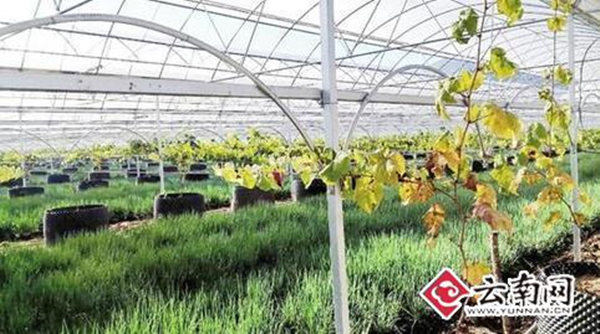Industrial Development Models to Lift SW China Counties Out of Poverty
GPIG by Cheng Yahui, March 1, 2017 Adjust font size:
Model 2: ‘Local Party Branch + Farmers’ Cooperatives’
Authorities in Daying Township, Binchuan County have created an innovative mechanism: guiding local people to set up their own cooperatives while bringing in professional support in technology, management and marketing from eligible enterprises.
Party workers of Hecun Village led the foundation of Binchuan Tianzi Agricultural Cooperative. This involved obtaining loans of 15 million yuan (U.S. $2.2 million), leasing farmland of 200 mu (33 acres) over a period of 20 years, and introducing a local agricultural technology company to run the daily operations.

The vineyard run by Binchuan Tianzi Agricultural Cooprative [yunnan.cn]
Each member household, having made an investment of 50,000 yuan (U.S. $7,280), can receive an annual return of 5,000 to 8,000 yuan (U.S. $728 to 1,165), as well as rental for their land amounting to 1,500 to 4,500 yuan (U.S. $219 to 657) per year. Moreover, able-bodied residents can take jobs with the cooperative to give themselves stable long-term incomes.
This kind of reward mechanism generates strong motivation in the villagers, and effectively transforms the circumstances of those who were previously indigent and trapped in a cycle of simply relying on government aid without making any effort for themselves. All of the 141 households in the village previously classified as destitute have involved themselves in the cooperative, enjoying an average rise in income of up to 20,000 yuan (U.S. $2,914).
In the village of Xinzhuang, Qiaodian Township, the local Party branch called upon Pu Guohong, an entrepreneur who had been working away from his hometown, to come back and start a tour company taking advantage of the region’s revolutionary tourist attractions.
Each of the village’s 13 poor households has invested 3,846 yuan (U.S. $560) in the company’s tourism projects, and the disadvantaged residents can also work with the company and receive a respective daily payment of 60 or 120 yuan (U.S. $8.70 and 17.40),in slack and busy farming seasons.
Since its inauguration on April 21, 2016, Xinzhuang Red Army Museum, one of the company’s programs, has welcomed over 80,000 visitors, enjoying revenues exceeding 700,000 yuan (U.S. $101,974) and bringing an average income increase of 6,000 yuan (U.S. $874) to each of the village’s families. The 13 poor households were each rewarded with an additional 4,093 yuan (U.S. $596) last year, thanks to their involvement in local tourism.

Xinzhuang Red Army Museum [yunnan.cn]
Yang Fahui, 33, a former grape producer in Xinzhuang, has been working with the company since last August, earning 2,500 yuan (U.S. $364) a month and thereby enjoying a much better standard of living.
“At the very beginning, people couldn’t understand why they should join the tourism project,” recalls Zi Rutao, chief of Qiaodian Township government. “But after listening to the persuasive explanations of the Party workers, they all made investments - they even offered their homesteads to the company to use for free.”
In addition to the residents in Xinzhuang, 98 families in the wider community of Haishao, at a higher administrative level, have also become stakeholders of Pu’s startup. They have each invested 5,000 yuan (U.S. $728) in his grape producing business. These investors shared dividends totaling 39,200 yuan (U.S. $5,711) last year.